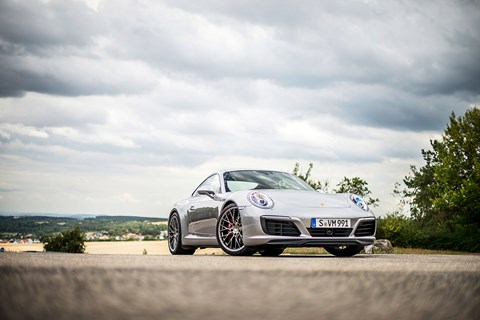► Porshce kill off N/A flat-six
► Bi-turbo six, the replacement
► Has it killed the car’s soul?
This is the biggest moment in the 911’s evolution since the water-cooled engine replaced air-cooling back in 1997. That change was mostly about noise levels, yet it sent shockwaves coursing through the 911-sphere after 34 years of air power. But the 911 survived, despite a challenging new look that made the 996 the first 911 to appear more revolution than evolution.
Now, as the current 991 model gets a mid-life overhaul for 2016, the change is all about efficiency – more torque from a downsized twin-turbocharged engine, less thirst, lower emissions. It’s the zeitgeist. All Porsches (bar the GT3) will be turbocharged from now on, so we had better get used to it. But the 911’s unique handling characteristics, its power delivery, its soundtrack, are delicate things. And of course the addition of all that plumbing puts onto the 911’s rear axle arguably the very last thing it needed: more weight.
This is our first chance to assess the new 911’s character, via a full-throttle shotgun ride in the company of 991 project boss August ‘Gustl’ Achleitner. And he’s in determined mood…
‘We shoot up to the right-hander like a hungry shark aiming for its prey’
Third gear, brake. Second gear, brake harder. Lift-off-and-turn-in smoothly, keep the torque flowing, then – just past the second apex – boot it! We have a drift, for one, two, three seconds, followed by a very graceful exit. ‘Could you ask the photographer to send me this picture, please,’ says Achleitner, with trademark dry humour.
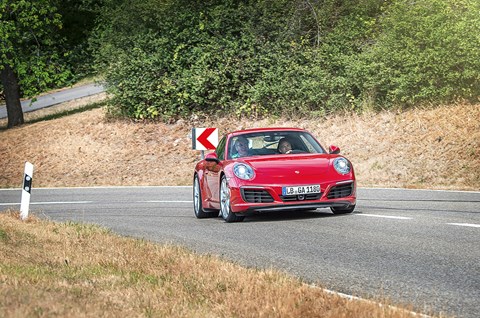 The 991/2 may be a mid-life revision, but chief designer Michael Mauer and his team have introduced subtle changes to help us mark it out – such as LED sidelights, 3D taillights, motorised nasal air-intakes which close above 10mph and an all-black new rear air-intake with longitudinal rather than east-west slats. ‘We made improvements where we felt a need for them,’ says Achleitner. ‘But we certainly did not mess with the character of the marque’s most iconic product.’
The 991/2 may be a mid-life revision, but chief designer Michael Mauer and his team have introduced subtle changes to help us mark it out – such as LED sidelights, 3D taillights, motorised nasal air-intakes which close above 10mph and an all-black new rear air-intake with longitudinal rather than east-west slats. ‘We made improvements where we felt a need for them,’ says Achleitner. ‘But we certainly did not mess with the character of the marque’s most iconic product.’
We’re spending the day in a red pre-production Carrera S. Camouflage? Two strips of body-colour tape at one end, two faux transparent taillight covers at the other. Already clearly visible are new xenons with trademark quad-dot daytime running lights, new 20in mag wheels, and the aforementioned new air-intake which now feeds the engine as well as the two intercoolers which are stowed away in the rear wings.
As before, the S moniker signals more grunt and more twist action (414bhp/369lb ft for the S, 365bhp/332lb ft for the Carrera). Originally, Porsche had contemplated equipping the base model with a 2.7-litre twin-turbo flat-six instead of the outgoing 3.4, but the consumption advantage was marginal and the added complexity would have hurt the budget. So it’s a 3.0-litre twin-turbo for the C2/C2S and 4.0 litres for the future top-of-the-line turbo (what will they call that – 911 Turbo turbo?). Although both engines gain only 20bhp in absolute power and 44lb ft, it’s the wide torque delta between the old and new torque curves which is claimed to make all the difference.
Achleitner prefers to operate his latest creation in manual mode, ‘so that I’m always close to that wide sweet spot where this engine responds without delay.’ Really without delay? From a passenger perspective, there is no turbo lag as such, but somehow the throttle action does not feel quite as electrifying as we remember it from the soon defunct GTS motor which reached its cut-out speed 500rpm later. Thanks to oodles of low-end urge, there is now no real need to tap the 2500rpm that lie between the torque summit and the performance peak.
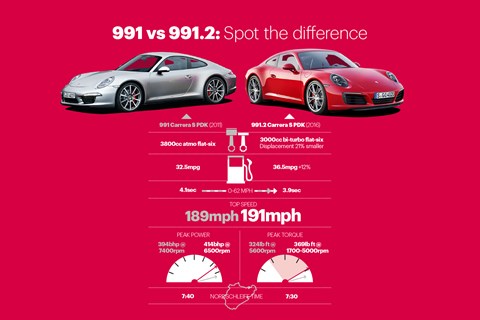
What about the noise?
‘We worked long and hard to make the 9A2 engines sound good, to give them a voice of their own,’ says Achleitner. ‘It was a difficult task, but I am happy with the result.’ While the run-of-the-mill versions are said to be a little more decibel-conscious, our test car is fitted with the vocal sports exhaust which trumpets through two fat tailpipes positioned below the numberplate. In Sex Pistols mode, full acceleration makes horses prance, has birds fly up in clusters, arches the backs of resident cats.
While the turbos breathe fresh air into the combustion chambers of the Carrera motor at no more than 0.9bar, the wind force rises to 1.1bar in the S engine. Chargers, intercoolers and related gubbins put that extra weight on the rear wheels, which normally is poison for the already critical weight distribution and handling balance (the S manual is 30kg heavier than before at 1420kg). ‘Not the case,’ says Achleitner. ‘On the contrary, the 991/2 feels even more relaxed at speed, the front axle in particular is firmly planted, and there is a new quality to the overall compliance.’ Gustl sets the drive programme in Sport, pushes the PSM stability button and cracks a grin. ‘We developed a slide-without-regret mode which permits astonishing drift angles yet prevents you reliably from ending up in the ditch. It’s a software thing supported by rear-wheel steering which can now be specified for the Carrera S.’ After a long pause, a postscript: ‘Someone said that speed plus stability equals excitement. They were right.’ Inspired by his own words, he sets the car power-oversteering through every corner that asks for it, peppering the side windows with insects.
The PDK-equipped 414bhp version can hit 62mph in 3.9sec, eclipsing its predecessor by 0.2sec and becoming the first Carrera to dip below the 4.0sec mark. But, while the top speed climbs by a token 2mph in both models, the big news is that fuel consumption drops by between 6% and 13%. In the case of the Carrera S it improves from 32.5mpg to 36.5mpg, and CO2 is down from 202g/km to an astonishing 174.
The 991/2 is a multi-talented, multi-tasking sports car. Among the new skills it acquires is waftability. Thanks to the long-legged top gear, the black box’s strong desire to cut revs in Drive, and the ability to coast under trailing throttle, this Porsche is a remarkably relaxed on-demand cross-country cruiser. But fear not, that distinct willingness to burn rubber and peel tarmac has been retained and refined – and pleasingly they’ve made it easier to access the dark side of the car’s character by fitting a mode dial to the new sports steering-wheel, 918-style (and Ferrari-manettino-style). There are five different attitudes to choose from: Normal, Individual, Sport, Sport Plus and Sport Response which is clearly tuned for track use only. The rotary control conducts the performance of drivetrain, dampers, rear air dam and exhaust. The choice is between comfort and sport, and you may mix and match your favourite traits and store them under Individual. Although this is clearly a step in the right direction, we would prefer to access engine and transmission separately. Why? Because there is no need to mate a very fast throttle response to an unsuitably low gear and correspondingly high revs.
Just as my stomach pit is about to make an emergency call, Gustl slows down, turns off and heads for the Pforzheim basin. Rounding up his new favourite ram with two fingers and a ginger right foot, he aims at every drainage grid and manhole cover. ‘What do you think? Can you feel the difference? We reprogrammed the PASM software, and this is the result: better low-speed ride, more progressive response, decent compliance even with 20in tyres. Worth mentioning in this context is the available front-axle lift which adds 30mm of ground clearance for steep ramps and tall kerbs.’ Unfortunately, this particular extra costs about as much as a dozen replacement aprons. Absolutely free of charge are the moreslippery aerodynamics which provide more downforce at speed while improving the drag coefficient.
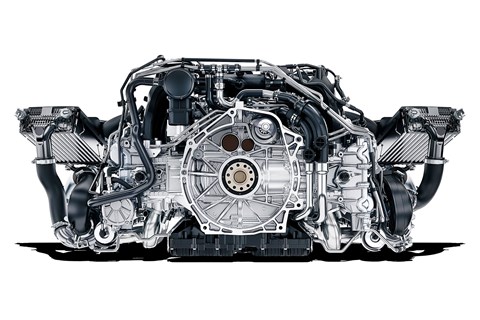
About the engine
New vertical-slat rear air-intake needed to feed twin-turbo engine as well as two intercoolers somehow squeezed inside the rear wings.
3.0-litre twin-turbo flat-six is a completely new engine. Maximum torque is available all the way from 1700rpm to 5000, creating more performance lower down and reducing fuel consumption. Red line at 7500rpm rarely needed.
Smaller capacity key to enhanced efficiency. Carrera S engine is 800cc smaller than before, yet generates 20bhp and 44lb ft more. Turbos force air into the combustion chambers at 0.9bar (1.1 in Carrera S).
And the new infotainment?
During our excursion through Swabian suburbia, there is plenty of time to check out the upgraded infotainment. The centre console itself has not changed much, but the new in-dash monitor offers better graphics and additional features such as Apple CarPlay and Google Earth. You can also go online, have messages read out to you, hop on Facebook, check out the weather and benefit from RTTI which is so much faster than yesterday’s old-school traffic news. Dubbed PCM4, the revised set-up boasts a smartphone-like touchscreen with swipe and zoom and scroll functions. Proximity sensors enlarge your fingertip’s icon of desire. Together with the mode switch, PCM4 marks an important step towards an all-new MMI system which will likely be launched in about four years’ time together with the 992. Which is another way of saying that 911 customers must wait until 2019 for a head-up display, additional assistance systems and the increasingly significant plug-in hybrid.
The new car is already on sale in the UK, although deliveries won’t start until December. Prices are modestly up, but then so is standard equipment. Carrera coupe will cost £76,412 (up from £73,509), but gets sat-nav and PASM. Carrera S will start at £85,857 (was £83,545). The new Carrera cabrio is £85,253, with the S cab set at £94,698. The most expensive options are again carbon-ceramic brakes and the PDK ’box. The manual seven-speeder, which was to be avoided at all costs when the 991 was first released, receives various upgrades, including a double-plate clutch for more precision and less effort.
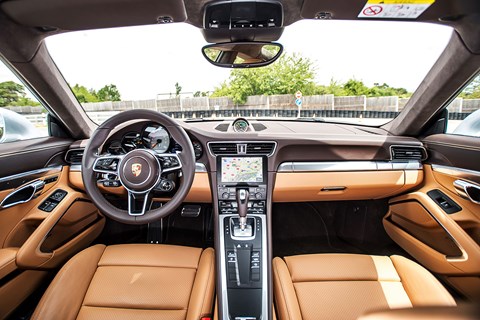
Change of pace, one more time. After country roads and city traffic, we are now heading for the A8 autobahn, direction Karlsruhe. Almost automatically, my driver morphs into cloak-and-dagger mode, pulling down his Zorro mask and giving it enough stick to allow me to figure out what this new engine really sounds like. Initially, full throttle feels like departing from the launch pad of an aircraft carrier, but after a while one gets used to the trademark kick-and-rush rhythm, the extrovert racing up the shrill tone-ladder, the intermittent bass-heavy lift-off jam session. It’s a nice noise – I like it. But it is different to the naturally aspirated engine – more techno than orchestra, more dense, with more nuances within a narrower acoustic frame. Do you know what it is – it’s modern. It’s the sound of the immediate future. I’m fairly certain we will grow to embrace it.
Against the inner stopwatch, however, the 991/2 feels barely faster than the more raucous, rev-hungry previous model. What puts the new car in a league of its own are the meatier low-to-mid-range punch and the greater forward urgency in seventh gear. But let’s for a moment forget about sheer velocity in a straight line. Let’s instead relish the confidence-inspiring directional stability, the securely tied-down front end, the immunity to that once highly critical mix of radius, rut, ridge and high speed. All of which helped this 911 to shave 10 whole seconds off the previous Carrera’s best Nordschleife lap time, posting 7min 30sec.
Dopey trucker with rear-view mirror allergy? Indicator-lazy sales rep in text-messaging trance? 60bhp-grandma on a fast-lane trip? No problem when you’re at the helm of the new Carrera S, which decelerates with vitriolic spontaneity, punching you in the head and simultaneously straining the neck muscles. Still on the credit side, the Porsche’s ability to follow a chosen line does not suffer when you must suddenly sway and swerve, changing lanes, braking hard.
The second time we exceed an indicated 170mph, a warning beep recommends to check the tyre pressures. For the first time, Gustl Achleitner blushes. ‘Instead of the high-performance setting, I chose the lower-pressure mode because it cushions the ride by a fraction,’ he says. ‘In combination with the softer front anti-roll bar, the suspension is now also less susceptible to lateral irritations and better balanced overall. Even a lift-off manoeuvre at 180mph will do no harm.’ Much too soon, LB-GA 1180 approaches the Heimsheim exit. At the lights, we turn right and storm up the hill, direction Weissach. One more chance to high-five the limiter at 7500rpm, to let my broad back cushion the full-throttle upshift kicks, to boo the fake double-declutch as we slow down for the main gate. Game over. Driver change? Sadly, not until the official launch in November. Until then there’s only one answer to ‘Oh Porsche, what have you done?’ Porsche done good.
